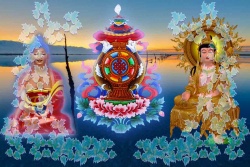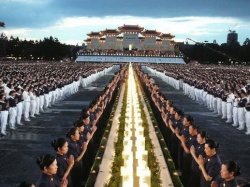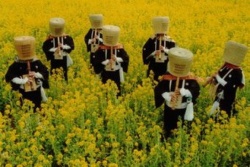Difference between revisions of "Tib., gTer-ston: Treasure Discoverer"
| Line 12: | Line 12: | ||
However, [[terma]], especially of the "[[Mind Treasure]]" class, have been and are being revealed up to the {{Wiki|present}} day and by members of all schools, including the [[Bönpo]] [[tradition]]. | However, [[terma]], especially of the "[[Mind Treasure]]" class, have been and are being revealed up to the {{Wiki|present}} day and by members of all schools, including the [[Bönpo]] [[tradition]]. | ||
| − | The exact number of [[terton]] throughout history is unknown, yet there [[exists]] a list | + | The exact number of [[terton]] throughout history is unknown, yet there [[exists]] a list [[Thondup]] 1986. p.189 which names 275 {{Wiki|individuals}} from the 11th to the 20th century. |
All these [[terton]] are classified - as are the [[terma]] - into the categories [[earth]] or [[mind]], but also according to the type(s) of teachings contained in their discoveries. | All these [[terton]] are classified - as are the [[terma]] - into the categories [[earth]] or [[mind]], but also according to the type(s) of teachings contained in their discoveries. | ||
| Line 20: | Line 20: | ||
| − | Among the [[108]] great ones, again five have a special {{Wiki|status}} and are called [[Terma King]]: | + | Among the [[108]] great ones, again five have a special {{Wiki|status}} and are called {{LTSW|Terma King's}}[[Terma King's]]: |
<poem> | <poem> | ||
Latest revision as of 13:38, 21 November 2015
Tibetan term for an individual who discovers, finds, recovers, or reveals one or more previously hidden terma (treasures); hidden for the sake of future generations and/or because certain teachings were judged too advanced for the then living.
Especially members of the Nyingmapa used this "hide and recover" method for the transmission of their teachings; a sensible technique when considering the various phases of persecution early Tantric Buddhism had to survive.
However, terma, especially of the "Mind Treasure" class, have been and are being revealed up to the present day and by members of all schools, including the Bönpo tradition.
The exact number of terton throughout history is unknown, yet there exists a list Thondup 1986. p.189 which names 275 individuals from the 11th to the 20th century.
All these terton are classified - as are the terma - into the categories earth or mind, but also according to the type(s) of teachings contained in their discoveries.
One thus finds expressions such as minor, major, and great terton.
Among the 108 great ones, again five have a special status and are called Terma King's:
1124-1192 Nyangral Nyima Oser (Nyang-ral Nyi-ma 'od-zer); short: Nyang Ralpa
1212-1273 Guru Chowang (Chos-dbang)
1346-1405 Dorje Lingpa (rDo-rJe gLing-pa), also known as Yungdrung Lingpa
1450-1521 Padma Lingpa (Pema gLing-pa)
1820-1892 Jamyang Khyentse Wangpo (Jam-dbyangs mKyhen-brtse'i dbang-po)
Although most known terton are men, there are some exceptions (Kunga Bum for example).
This is especially interesting in light of the fact that the revelation of most terma, i.e. those of the "Mind Treasure" variety (Tib., dgongs-gTer), is dependent on having a suitable partner for the rituals of the fulfillment yoga stage;
rituals designed to achieve the necessary state of mind known as bliss-emptiness.
It is in this state of heightened awareness and lucidity, that the terton experiences his or her visions and is able to first receive and then translate the revelation in question.
Women, so it seems, are more often compassionate and giving for the sake of a fellow man (sustaining his bliss and vision); and/or most men possibly lack the ability to aid and sustain a woman in her efforts.
Another prerequisite for being/becoming a terton is the ability to consciously remember one or more of one's past lives;
i.e. earlier incarnations, especially those in which the terton in question was a direct student of Padmasambhava (for an example, see the incarnation line Pema Sal to Pema Ledrel Tsal to Longchenpa).


